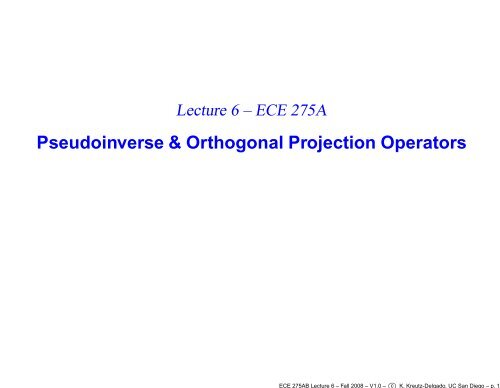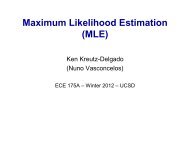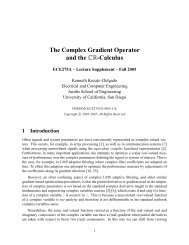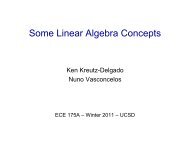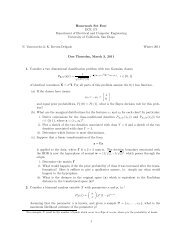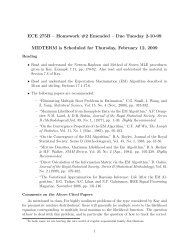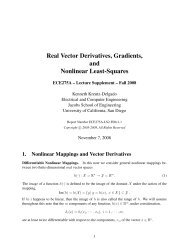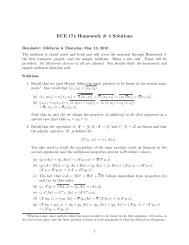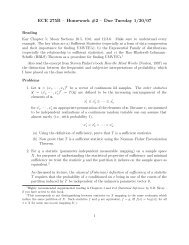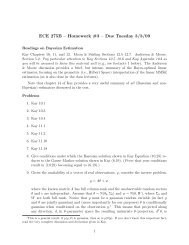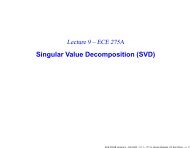Pseudoinverse & Orthogonal Projection Operators - UCSD DSP Lab ...
Pseudoinverse & Orthogonal Projection Operators - UCSD DSP Lab ...
Pseudoinverse & Orthogonal Projection Operators - UCSD DSP Lab ...
You also want an ePaper? Increase the reach of your titles
YUMPU automatically turns print PDFs into web optimized ePapers that Google loves.
Lecture 6 – ECE 275A<br />
<strong>Pseudoinverse</strong> & <strong>Orthogonal</strong> <strong>Projection</strong> <strong>Operators</strong><br />
ECE 275AB Lecture 6 – Fall 2008 – V1.0 – c○ K. Kreutz-Delgado, UC San Diego – p. 1/
The Four Fundamental Subspaces of a Linear Operator<br />
For a linear operator A : X → Y,<br />
Defining the adjoint A ∗ : Y → X by<br />
X = N(A) ⊥ ⊕ N(A) and Y = R(A) ⊕ R(A) ⊥<br />
we obtain (as was shown last lecture)<br />
yielding<br />
〈y, Ax〉 = 〈A ∗ y, x〉<br />
R(A ∗ ) = N(A) ⊥ and N(A ∗ ) = R(A) ⊥<br />
X = R(A ∗ ) ⊕ N(A) and Y = R(A) ⊕ N(A ∗ )<br />
• The four fundamental subspaces of A are the orthogonally complementary<br />
subspaces R(A) and N(A ∗ ) and the orthogonally complementary subspaces,<br />
N(A) and R(A ∗ ).<br />
ECE 275AB Lecture 6 – Fall 2008 – V1.0 – c○ K. Kreutz-Delgado, UC San Diego – p. 2/
Because<br />
Four Fundamental Subspaces – Cont.<br />
〈y, Ax〉 = 〈A ∗ y, x〉 ⇔ 〈Ax, y〉 = 〈x, A ∗ y〉 ⇔ 〈x, A ∗ y〉 = 〈Ax, y〉<br />
the adjoint of A ∗ is (merely by definition!)<br />
A ∗∗ (A ∗ ) ∗ = A<br />
Thus the relationships between A and A ∗ and their four fundamental subspaces<br />
are entirely symmetrical,<br />
A : X → Y , A ∗ : Y → X<br />
〈y, Ax〉 = 〈A ∗ y, x〉 , 〈x, A ∗ y〉 = 〈Ax, y〉<br />
Y = R(A) ⊕ N(A ∗ ) , X = R(A ∗ ) ⊕ N(A)<br />
R(A) = N(A ∗ ) ⊥ , R(A ∗ ) = N(A) ⊥<br />
ECE 275AB Lecture 6 – Fall 2008 – V1.0 – c○ K. Kreutz-Delgado, UC San Diego – p. 3/
The <strong>Pseudoinverse</strong> Solution – Cont.<br />
Because of this symmetry, sometimes we can get twice the number of results per<br />
derivation. For example, here we prove that<br />
from which it directly follows that<br />
Proofs of the first statements:<br />
N(A) = N(A ∗ A) and R(A ∗ ) = R(A ∗ A)<br />
N(A ∗ ) = N(AA ∗ ) and R(A) = R(AA ∗ )<br />
• If x ∈ N(A), then obviously x ∈ N(A ∗ A). On the other hand<br />
x ∈ N(A ∗ A) ⇔ A ∗ Ax = 0<br />
⇔ 〈ξ, A ∗ Ax〉 = 0, ∀ξ<br />
⇔ 〈Aξ, Ax〉 = 0, ∀ξ<br />
⇒ 〈Ax, Ax〉 = Ax 2 = 0<br />
⇒ x ∈ N(A)<br />
ECE 275AB Lecture 6 – Fall 2008 – V1.0 – c○ K. Kreutz-Delgado, UC San Diego – p. 4/
Proofs continued:<br />
Four Fundamental Subspaces – Cont.<br />
• Having established that N(A) = N(A ∗ A), we have<br />
x ∈ R(A ∗ A) ⇔ x ⊥ N(A ∗ A) (using the fact that (A ∗ A) ∗ = A ∗ A)<br />
⇔ x ⊥ N(A)<br />
⇔ x ∈ R(A ∗ )<br />
Note that we have also established that<br />
ν(A) = ν(A ∗ A), r(A) = r(AA ∗ ), ν(A ∗ ) = ν(AA ∗ ), and r(A ∗ ) = r(A ∗ A)<br />
Furthermore, with A a mapping between two finite dimensional spaces one can show<br />
Note that dim R(A) = dim R(A ∗ ).<br />
r(A ∗ A) = r(AA ∗ ) = r(A) = r(A ∗ )<br />
ECE 275AB Lecture 6 – Fall 2008 – V1.0 – c○ K. Kreutz-Delgado, UC San Diego – p. 5/
Adjoint-Based Conditions for a P-Inv Solution<br />
• Having defined the adjoint we obtain the geometric conditions for a pseudoinverse<br />
solution,<br />
1. Geometric Cond. for a Least-Squares Solution: e = y − Ax ′ ∈ N(A ∗ )<br />
2. Geometric Cond. for a Minimum Norm LS Solution: x ′ ∈ R(A ∗ )<br />
• The geometric conditions conditions easily lead to the algebraic conditions<br />
1. Algebraic Cond. for an LS Solution – The Normal Equation: A ∗ Ax = A ∗ y<br />
2. Algebraic Cond. for a Minimum Norm LS Solution: x = A ∗ λ<br />
• When the domain has a metric matrix Ω and the codomain has metric matrix W ,<br />
then (assuming the standard canonical-basis representations of vectors and linear<br />
operators) the adjoint operator is<br />
A ∗ = Ω −1 A H W<br />
ECE 275AB Lecture 6 – Fall 2008 – V1.0 – c○ K. Kreutz-Delgado, UC San Diego – p. 6/
Solving for the P-Inv Solution – I: A One-to-One<br />
• If a linear mapping A between finite dimensional spaces is either onto or<br />
one-to-one, we say that A is full-rank. Otherwise A is rank deficient.<br />
• If A is a matrix which is onto, we say that it is full row rank.<br />
• If A is a matrix which is one-to-one we say that it is full column rank.<br />
• If A is one-to-one, then the least-squares solution to the inverse problem y = Ax<br />
is unique. Thus the second algebraic condition, which serves to resolve<br />
non-uniqueness when it exists, is not needed.<br />
• A one-to-one yields A ∗ A one-to-one and onto, and hence invertible. Thus<br />
from the first algebraic condition (the normal equation), we have<br />
A ∗ Ax = A ∗ y ⇒ ˆx = (A ∗ A) −1 A ∗ y = A + y<br />
showing that the pseudoinverse operator that maps measurement y to the<br />
least-squares solution ˆx is given by<br />
A one-to-one ⇒ A + = (A ∗ A) −1 A ∗<br />
• Directly solving the normal equation A ∗ Ax = A ∗ y is a numerical superior<br />
way to obtain ˆx. The expressions A + = (A ∗ A) −1 A ∗ and ˆx = A + y are<br />
usually preferred for mathematical analysis purposes.<br />
ECE 275AB Lecture 6 – Fall 2008 – V1.0 – c○ K. Kreutz-Delgado, UC San Diego – p. 7/
Solving for the P-Inv Solution – II: A Onto<br />
• If A is onto (has a full row rank matrix representation), then there is always a<br />
solution to the inverse problem y = Ax. Thus the first algebraic condition (the<br />
normal equation), which serves to obtain an approximate solution and stands in for<br />
y = Ax when it is inconsistent, is not needed for our analysis purposes. (It may<br />
have numerical utility however).<br />
• A onto yields A ∗ A onto and one-to-one, and hence invertible. Thus from the<br />
second algebraic condition and the (consistent) equation y = Ax we have<br />
x = A ∗ λ ⇒ y = Ax = AA ∗ λ ⇒ λ = (AA ∗ ) −1 y ⇒ x = A ∗ (AA ∗ ) −1 y = A + y<br />
showing that the pseudoinverse operator that maps measurement y to the<br />
least-squares solution ˆx is given by<br />
A onto ⇒ A + = A ∗ (AA ∗ ) −1<br />
• Directly solving the equation AA ∗ λ = y for λ and then computing ˆx = A ∗ λ is<br />
a numerical superior way to obtain ˆx. The expressions A + = A ∗ (AA ∗ ) −1<br />
and ˆx = A + y are usually preferred for mathematical analysis purposes.<br />
• What if A is neither one-to-one nor onto? How to compute the p-inv then?<br />
ECE 275AB Lecture 6 – Fall 2008 – V1.0 – c○ K. Kreutz-Delgado, UC San Diego – p. 8/
<strong>Orthogonal</strong> <strong>Projection</strong> <strong>Operators</strong><br />
Suppose that P = P 2 is an orthogonal projection operator onto a subspace V along its<br />
orthogonal complement V ⊥ . Then I − P is the orthogonal projection operator onto V ⊥<br />
along V. For all vectors x1 and x2, we have<br />
〈Px1,(I − P)x2〉 = 0 ⇔ 〈(I − P) ∗ Px1, x2〉 = 0 ⇔ (I − P) ∗ P = 0 ⇔ P = P ∗ P<br />
which yields the property<br />
<strong>Orthogonal</strong> <strong>Projection</strong> <strong>Operators</strong> are Self-Adjoint: P = P ∗<br />
Thus, if P = P 2 , P is a projection operator. If in addition P = P ∗ , then P is an<br />
orthogonal projection operator.<br />
• A + A : X → X and AA + : Y → Y are both orthogonal projection operators. The<br />
first onto R(A ∗ ) ⊂ X , the second onto R(A) ⊂ Y.<br />
ECE 275AB Lecture 6 – Fall 2008 – V1.0 – c○ K. Kreutz-Delgado, UC San Diego – p. 9/


